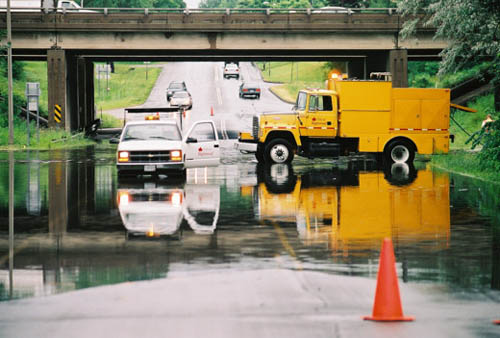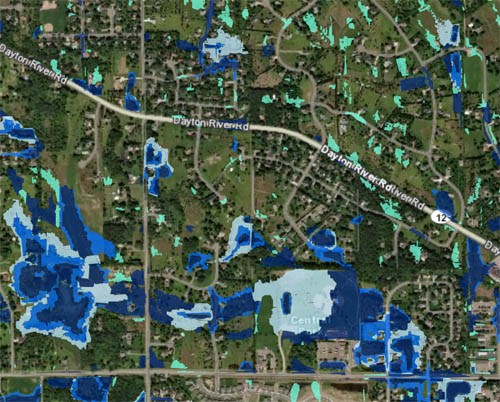Warming temperatures. Deluges of rain. Increased freeze and thaw cycles. Changes in climate are already affecting key infrastructure like sewer pipes, transit stops and roads.
 To help plan for impacts of a changing climate, the Metropolitan Council is developing a Climate Vulnerability Assessment. The assessment is a set of data and tools that will help the Council and local communities plan for and manage public infrastructure to increase its lifespan and reduce costs.
To help plan for impacts of a changing climate, the Metropolitan Council is developing a Climate Vulnerability Assessment. The assessment is a set of data and tools that will help the Council and local communities plan for and manage public infrastructure to increase its lifespan and reduce costs.
“Being able to prioritize where our assets and systems are vulnerable is valuable from both a stewardship and resilience perspective,” said Council Chair Alene Tchourumoff. “It is important that we’re thinking proactively about flooding, for example, and how we can get ahead of it.
“Providing this information to local governments is also important so they can take and use it and see if it ties to what they are experiencing,” she said. “Local knowledge is deep and valuable. They know their systems better than anyone else.”
New mapping tool looks at localized flood risk
The most recent addition to the assessment is a chapter about flood risk for transportation/transit, and a mapping tool that shows areas of potential localized flood risk. Localized flooding occurs when rain overwhelms drainage systems and waterways, making its way into basements, yards and streets.
 The mapping tool uses what are called bluespots to show where and to what extent a location may flood based on low areas. These areas may fill with water during short-term extreme rain events or when stormwater infrastructure is overwhelmed or obstructed. The map identifies flood impact zones where, for example, highways may flood and detours need to be established or where bus routes may flood and need to be rerouted.
The mapping tool uses what are called bluespots to show where and to what extent a location may flood based on low areas. These areas may fill with water during short-term extreme rain events or when stormwater infrastructure is overwhelmed or obstructed. The map identifies flood impact zones where, for example, highways may flood and detours need to be established or where bus routes may flood and need to be rerouted.
Currently the mapping tool is based solely on elevation data; the addition of local stormwater infrastructure data would strengthen the tool, explained Eric Wojchik, part of the Council team developing the assessment. Communities can combine their local data and assets to the flood map data to conduct their own analysis and screening, he said.
The regional MetroGIS collaboration is planning to create a region-wide dataset on stormwater infrastructure, Wojchik said. A working group is currently determining how to integrate the varying local formats the data come in.
In addition to the mapping tool, staff are creating a story map for localized flooding that will provide examples of vulnerable assets of Council systems and where potential risk areas are located. The story map will communicate the information in a way that’s easy for a layperson to understand.
Proactive strategies to protect transportation infrastructure
The assessment proposes strategies to lessen the impacts of localized flooding for each element of the transportation system. Examples related to light rail and commuter rail include:
-
Perform a site review and audit of all rail segments subject to the highest risk of localized flooding.
-
Enact protocols for relief transit vehicles in advance of forecasted severe storms.
-
Work with local jurisdictions and stakeholders to enact stormwater management best practices and ongoing maintenance in the right-of-way along LRT and commuter rail routes.
-
Prioritize vulnerable station areas to communicate localized flooding potential to riders in a variety of formats and languages.
Applying the flood data at the local level
The South Washington Watershed District and its member communities used the localized flooding data as part of a larger effort to assess the district’s vulnerability to climate change, explained Nathan Campeau, Senior Water Resources Engineer at Barr Engineering.
“The mapping tool very quickly gave us a high-level look at areas of potential inundation,” Campeau said. “Combining that with local infrastructure data, we were able to see which storm sewer pipes are the most important to inspect, maintain and even replace to mitigate the risk of flooding.”
Helping communities prioritize heat mitigation strategies
.aspx) Another focus of the climate vulnerability assessment is extreme heat. Though heat waves have not shown an upward trend in the region yet, heat waves are more likely to occur beyond the year 2025, according to the Minnesota State Climatology Office. Human vulnerability to extreme heat is of concern to many stakeholders in the region, particularly county health departments and agency partners.
Another focus of the climate vulnerability assessment is extreme heat. Though heat waves have not shown an upward trend in the region yet, heat waves are more likely to occur beyond the year 2025, according to the Minnesota State Climatology Office. Human vulnerability to extreme heat is of concern to many stakeholders in the region, particularly county health departments and agency partners.
The assessment’s Extreme Heat Map Tool shows land surface temperature data for the seven-county metro area. The tool demonstrates the difference in land surface temperature across the metro region due to the existing built and natural environment — a product of land use, site design and land cover.
Story map shows examples of how data can be applied
The Council has launched a new story map titled Keeping Our Cool: Extreme Heat in the Twin Cities Region. The story map explores the causes of the urban heat island effect within our region. The resource includes localized examples and recommended mitigation strategies for stakeholder consideration. The resource details why extreme heat matters and how communities can incorporate extreme heat analysis into decision-making.
Adding equity to the considerations of heat mitigation priorities
The heat mapping data was one of several layers that staff at Hennepin County used to create a map of priority areas for planting trees, said Jen Kullgren, forester in the county’s Energy and Environment Department. Staff selected and devised a scoring system for 18 different GIS data layers to create the map.
In addition to data one might expect in such an analysis — land cover, heat data, air quality, and population density — staff also brought in data related to income, poverty, home ownership, asthma hospitalization and more.
“We had a lot of conversations about disparities and how we could prioritize areas that don’t see the level of investment that other areas do,” Kullgren said.
“Our goal is that local governments and others use this data to prioritize policy and implementation strategies, for example, targeted tree planting or design improvements that may mitigate risks associated with extreme heat,” Wojchik said. “By changing our built and natural environments through policies, implementation and sensible site design, we can reduce this extreme heat effect and thereby improve public health and livability.”
For more information